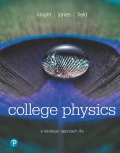
The Defibrillator
A defibrillator is designed to pass a large current through a patient’s torso in order to stop dangerous heart rhythms. Its key part is a capacitor that is charged to a high voltage. The patient’s torso plays the role of a resistor in an RC circuit. When a switch is closed, the capacitor discharges through the patient’s torso. A jolt from a defibrillator is intended to be intense and rapid; the maximum current is very large, so the capacitor discharges quickly. This rapid pulse depolarizes the heart, stopping all electrical activity. This allows the heart’s internal nerve circuitry to reestablish a healthy rhythm.
A typical defibrillator has a 32 μF capacitor charged to 5000 V. The electrodes connected to the patient are coated with a
Which pair of graphs in Figure P23.82 best represents the capacitor voltage and the current through the torso as a function of time after the switch is closed?

Want to see the full answer?
Check out a sample textbook solution
Chapter 23 Solutions
College Physics: A Strategic Approach (4th Edition)
Additional Science Textbook Solutions
Microbiology: An Introduction
Genetic Analysis: An Integrated Approach (3rd Edition)
Applications and Investigations in Earth Science (9th Edition)
Organic Chemistry (8th Edition)
Anatomy & Physiology (6th Edition)
Microbiology with Diseases by Body System (5th Edition)
- Electrons in a conductor are moving down the page. A proton outside the wire is moving to the right. What is the direction of the magnetic force acting on the proton?arrow_forwardWhat is the resistance of an ideal voltmeter and the resistance of an ideal ammeter? Resistance of an ideal voltmeter Resistance of an ideal ammeter infinite A. zero B. zero zero C. infinite infinite D. infinite zeroarrow_forwardvariable resistor with a resistance range of 0 to 6.0 KQ is connected in series with two resistors of fixed value 6.0 KQ. The cell in the circuit has an emf of 18 V and a negligible internal resistance. 18 V X Y 6.0 ΚΩ 6.0 ΚΩ 0 - 6.0 ΚΩ What is the maximum range of potential difference that can be observed between X and Y?arrow_forward
- A positive point charge of magnitude 1.0 μC and a point charge q are separated by a distance d. electron 1.0 με An electron is placed at a distance d from the +1.0 μC charge. The electric force on the electron is zero. What is q?arrow_forwardTwo point charges of +4q and -q are placed a fixed distance apart. Where is the electric field strength equal to zero? B. +49 D. A network of three resistors is connected to a cell of emf 12V and internal resistance R of 2.0 Q as shown.arrow_forwardThree point charges of equal magnitude are placed at the vertices of an equilateral triangle. The signs of the charges are shown. Point P is equidistant from the vertices of the triangle. What is the direction of the resultant electric field at P? B.arrow_forward
- A magnetic force per unit length F acts on P due to Q. The distance between the wires is increased to 2d and the current in Q is decreased to 1/2. P Q P 12 2d What is the magnetic force per unit length that acts on P due to Q after the changes?arrow_forwardAn electric field is established between two electrodes separated by distance d, held at a potential difference of V. A charged particle in this field experiences a force F. What is the charge on the particle?arrow_forwardCurrent / flows in a conducting wire. What expression correctly gives the number of electrons passing through a cross section of the wire in a time t?arrow_forward
- Two 1.0 resistors are placed in a circuit with two 6 V cells of negligible internal resistance as shown. 6V 6V 49 1.00 1.092 What is the reading on the ideal ammeter?arrow_forwardConductor X is connected to a cell of emf E. A power of 16 W is dissipated in X. Conductor Y is made from the same material with the same diameter as X but is twice as long. A cell of emf 2E is connected to Y. Both cells have negligible internal resistance. What power is dissipated in Y? E 2E 中心 Y Two long parallel wires P and Q are a distance d apart. They each carry a current.arrow_forwardNo chatgpt pls will upvotearrow_forward
 Principles of Physics: A Calculus-Based TextPhysicsISBN:9781133104261Author:Raymond A. Serway, John W. JewettPublisher:Cengage Learning
Principles of Physics: A Calculus-Based TextPhysicsISBN:9781133104261Author:Raymond A. Serway, John W. JewettPublisher:Cengage Learning Physics for Scientists and EngineersPhysicsISBN:9781337553278Author:Raymond A. Serway, John W. JewettPublisher:Cengage Learning
Physics for Scientists and EngineersPhysicsISBN:9781337553278Author:Raymond A. Serway, John W. JewettPublisher:Cengage Learning Physics for Scientists and Engineers with Modern ...PhysicsISBN:9781337553292Author:Raymond A. Serway, John W. JewettPublisher:Cengage Learning
Physics for Scientists and Engineers with Modern ...PhysicsISBN:9781337553292Author:Raymond A. Serway, John W. JewettPublisher:Cengage Learning Physics for Scientists and Engineers: Foundations...PhysicsISBN:9781133939146Author:Katz, Debora M.Publisher:Cengage Learning
Physics for Scientists and Engineers: Foundations...PhysicsISBN:9781133939146Author:Katz, Debora M.Publisher:Cengage Learning College PhysicsPhysicsISBN:9781938168000Author:Paul Peter Urone, Roger HinrichsPublisher:OpenStax College
College PhysicsPhysicsISBN:9781938168000Author:Paul Peter Urone, Roger HinrichsPublisher:OpenStax College





